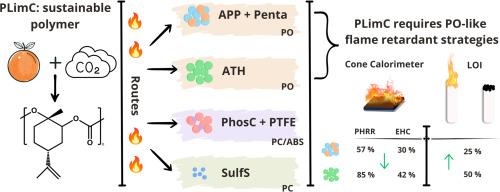Translating flame retardant strategies: Analogy from polyolefins and bisphenol a polycarbonates to poly(limonene carbonate)
IF 7.4
2区 化学
Q1 POLYMER SCIENCE
引用次数: 0
Abstract
Poly(limonene carbonate)—PLimC—offers a novel sustainable alternative to traditional polymers, as it is derived from renewable limonene and carbon dioxide as monomers. Proposing PLimC as a future technical polymer for applications in electrical and electronic (E&E) devices, construction, and transportation, PLimC must meet specific fire prevention standards to be deemed suitable. Starting from the chemical structure of PLimC, strategies in analogy to flame retarded bisphenol A polycarbonates (PC), PC blends, and polyolefins (PO) are investigated to identify the most effective route to enhance the flame resistance of PLimC. This study utilized four halogen-free flame-retardant (FR) systems: APP + pentaerythritol (standard intumescent system in PO), a phosphorus flame retardant+PTFE as anti-dripping agent (used in PC blends), metal hydroxide ATH (widely used in PO), and potassium sulfonate salt (specific solution for PC). Applying these FRs at typical PC, PC blends, and PO loadings, we aim to understand their effect on PLimC and evaluated the different flame-retardant routes. Our experimental evaluations focused on the thermal properties, flammability, and fire behavior of each system. ATH emerged as the most effective, reducing the effective heat of combustion from 29.3 MJ kg⁻¹ to 18.6 MJ kg⁻¹ and the total heat evolved from 95 to 55 MJ m⁻². It also resulted in an increase in the limiting oxygen index from 17.1 to 26 vol.-% O2, along with a UL 94 HB40 rating. The intumescent system also exhibited considerable flame retardancy, highlighting the similarity of PLimC’s fire behavior to that of PO rather than PC.

阻燃策略的转换:从聚烯烃和双酚a聚碳酸酯到聚柠檬烯碳酸酯的类比
聚碳酸柠檬烯(plimc)是传统聚合物的一种新型可持续替代品,因为它是由可再生的柠檬烯和二氧化碳作为单体衍生而来。PLimC作为一种未来的技术聚合物应用于电气和电子设备,建筑和运输,PLimC必须满足特定的防火标准才能被认为是合适的。从PLimC的化学结构出发,研究了类似于阻燃双酚A聚碳酸酯(PC)、PC共混物和聚烯烃(PO)的阻燃策略,以确定提高PLimC阻燃性的最有效途径。本研究使用了四种无卤阻燃体系:APP +季戊四醇(PO中的标准膨胀体系)、磷系阻燃剂+聚四氟乙烯(PTFE)作为防滴剂(用于PC共混物)、金属氢氧化物ATH(广泛用于PO)和磺酸钾盐(PC专用溶液)。将这些阻燃剂应用于典型的PC、PC共混物和PO负载,我们的目标是了解它们对PLimC的影响,并评估不同的阻燃路线。我们的实验评估集中在每个系统的热性能、可燃性和火灾行为上。ATH是最有效的,将有效燃烧热从29.3 MJ kg -⁻¹减少到18.6 MJ kg -⁻¹,总热量从95 MJ m -⁻²减少到55 MJ m -⁻²。它还导致极限氧指数从17.1增加到26 vol.-% O2,以及UL 94 HB40等级。膨胀体系也表现出相当大的阻燃性,突出PLimC的燃烧行为与PO而不是PC的相似。
本文章由计算机程序翻译,如有差异,请以英文原文为准。
求助全文
约1分钟内获得全文
求助全文
来源期刊

Polymer Degradation and Stability
化学-高分子科学
CiteScore
10.10
自引率
10.20%
发文量
325
审稿时长
23 days
期刊介绍:
Polymer Degradation and Stability deals with the degradation reactions and their control which are a major preoccupation of practitioners of the many and diverse aspects of modern polymer technology.
Deteriorative reactions occur during processing, when polymers are subjected to heat, oxygen and mechanical stress, and during the useful life of the materials when oxygen and sunlight are the most important degradative agencies. In more specialised applications, degradation may be induced by high energy radiation, ozone, atmospheric pollutants, mechanical stress, biological action, hydrolysis and many other influences. The mechanisms of these reactions and stabilisation processes must be understood if the technology and application of polymers are to continue to advance. The reporting of investigations of this kind is therefore a major function of this journal.
However there are also new developments in polymer technology in which degradation processes find positive applications. For example, photodegradable plastics are now available, the recycling of polymeric products will become increasingly important, degradation and combustion studies are involved in the definition of the fire hazards which are associated with polymeric materials and the microelectronics industry is vitally dependent upon polymer degradation in the manufacture of its circuitry. Polymer properties may also be improved by processes like curing and grafting, the chemistry of which can be closely related to that which causes physical deterioration in other circumstances.
 求助内容:
求助内容: 应助结果提醒方式:
应助结果提醒方式:


